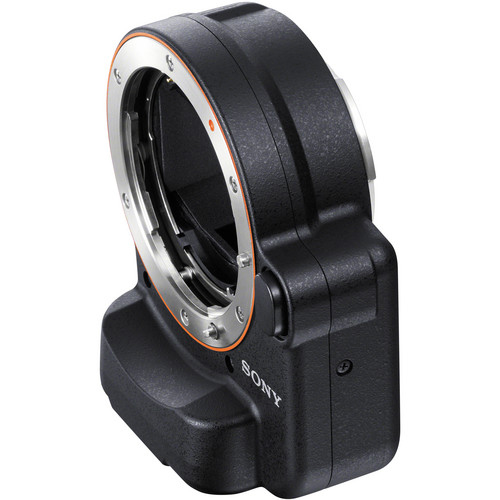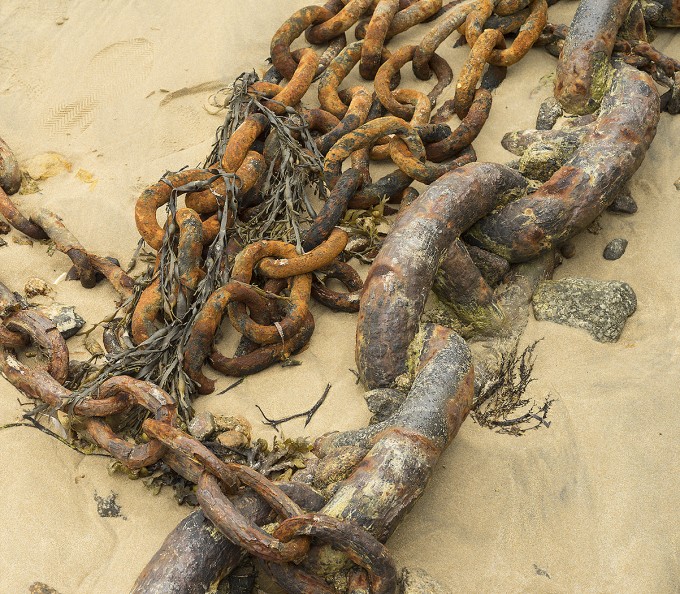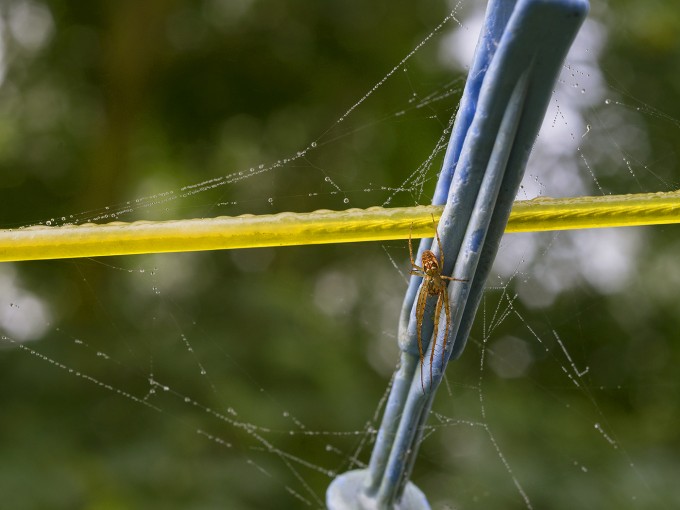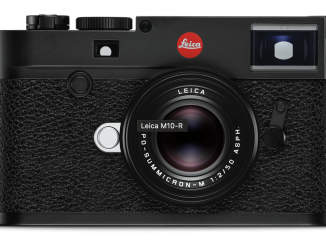The Sony LA-EA4?
By Bill Spencer
If you have an A7 series camera, looking at one of these has probably crossed your mind at some time. The possibility of using Sony A series lenses as well the high performance older Minolta FA lens for me was quite irresistible. So when I purchased my A7II 9 months ago I quickly followed with the LA-EA4 so I could use my collection of Sony A series lens and some much older AF Minolta ones (which quite frankly are horrible if you have to manually focus them).The LA-EA3 adapter is good for Sony A mount lenses that have a built-in motor as it does not have a motor of its own. It has full electronic coupling betwixt camera and lens – so no good for screw drive lens. I just mention that for the odd person who is new to the system.
The LA-EA4 adapter is not cheap! it is powered from the puny camera battery but strangely does not effect battery life as far as I can tell. Inside contains a semi translucent 45deg mirror which transfers about half a stop of light to a focus sensor array which covers about a quarter the image area with cross type sensors. There is a micro AF adjust but I have never had to use it. The adapter has a motor that has a lot of grunt, is loud, and is fast. The noise means that it is not much good for stealth street stuff. The power and speed means that Sony A lenses work very well. I have the lightweight 70 – 300mm G lens which has its own motor which overrides the adapter unit and is match made in heaven with impressive speed and accuracy all the way from closest focus to long distance even in really low light. The Sony 11 – 18 wide also works rather well using the adapter motor. Full frame is covered down to 15mm (it is an APSC lens). Continuing down to 11mm means you have to crop to the 15mm equivalent, but a minor advantage is that you can get square, landscape and portrait crops of about 18 from 24 megs from the images. The ‘steady shot’ function works seamlessly with Sony or Minolta lenses as does the lens profiling information which is useful. I think all the camera functions still work with the adapter – I have not yet found one that does not but, as you know, there are many and varied options and if you are like me once you have found a decent setup further messing gives way to picture making.
Playing with the A series APSC kit zoom is just ‘OK’ with the option of a cropped image in camera or a heavily vignetted full frame result. losing the half stop as well making it horrible all round.
All the Minolta AF lenses I have tried have worked but they are 20 to 30 years old so can be a bit variable. Both the 50mm F1.7 and 28mm F2.8 are quick and so far have coped with the power of the LA-EA4’s motor. The problem is that when auto focusing the ‘hard stops’ mechanism of the older lenses (at minimum and infinity focus) are not dampened in any way. My favourite lens, a 50mm macro has been literally ripped apart by this characteristic. A 35 – 70 zoom also works well but the weight of the focusing lens group gives it quite a kick as it works. This lens however works even better on my older A65 camera which has a more gentle focusing action.
Alert Squirrel 1/60 sec at F8 ISO-1000 300mm zoom
You cannot help but notice there is a big lump sticking down from the adapter that contains the mechanism. It has a tripod mount to use instead of the cameras tripod mount. The lump fouls everything up so the adapter mount is the one to use. I have only tried it a couple of times on a tripod and it works fine. Part of the idea of a steadyshot camera, especially one with 4 stops shadow recovery, is to reduce need for a tripod. The size and shape of the lump has pluses and minuses depending on the lens in use. For me, with telephoto and zoom lenses I think it helps comfort and usability, but with shorter lenses it can become annoying and uncomfortable to the point I now prefer to put on a manual lens and go retro.
Other mechanicals such as the metal mounts are properly tight in use with no play except for the plastic mount Nex lenses which feel like they are going to fall off at any moment. The mount / dismount button is located on the left side and is good for a right-handed person ie press the button with your weaker hand and hold the lens with your better hand. The adapter seems strongly constructed in the ‘plastic fantastic’ tradition, but mine has a stress crack in one corner of the mirror which seems in my imagination to be getting bigger as time goes on. I do not think it is weather proof although I have been caught a couple of times in a sharp shower and suffered no damage.
Chains 1/60 sec F10 at F10 ISO-200 50mm prime
Dust is less of a problem than I thought it would be. The few specks that have settled on both sides the mirror have been easy to get off with blower and a couple of more stubborn ones came away with a soft lens brush. Looking through it with a led torch it is still as clear as new except for the crack in the corner.
I left submitting this discussion until I had installed and used the latest much hyped A7II firmware version 1.2 update to see if anything was added or lost. Mechanically and functionally it has not made a noticeable difference to me. But! If I could roll back to a previous firmware version I would but it is not possible. It may be my imagination but the new uncompressed 14 bit files seem to have a noticeable sharpening mask added and they are huge. The 14 bit uncompressed files (as this it written) will not open into the latest Photoshop or Capture 1 and so far I have had to rely on the Sony software. Setting the ‘camera’ dialogue to ‘neutral’ in the software almost gets rid of the sharpening but not quite. Fortunately Compressed RAW when opened into Photoshop or Photoplus do not seem to be changed.
Spider on clothes peg 1/90 sec at F9.5 ISO-800 50mm macro
Was it worth it? The answer for me is a definite Yes. Just to be able to use the 70 -300G zoom is enough. Shorter primes are a 50 – 50 proposition. For me, manual lenses are often more satisfying and precise. After all I can pre-focus and set my depth of field ahead of time just leaving the final quick tweak at taking stage whilst leaving the camera to sort out shutter speed or ISO as desired. Remember as well the LA-EA3 is worth looking at if you are using the latest firmware update and Sony lenses with built-in motors. Add to that the improved on chip focusing and there is of course that half stop bonus. I would definitely hire or borrow before parting with the cash.
Bill








Anyone have experience with the LAEA3 and the new firmware on the A7II? It theoretically should be better AF than my LAEA4, but I was curious about actual performance.
Nice review of the LAEA4, by the way, very well written, and I agree with it all.
If the A7rii is comparable in speed to the a7ii using the LA-EA3 adapter the LA-EA4 still performs faster in crappy light. I was using the 70-400 G on the rii, so maybe that doesn’t focus as quick as old the Minolta 70-300 RS.
So I’m on number three of this adapter. I have broken one and have two others. The break is completely my fault by touching the flimsy beam splitter. DO NOT TOUCH THAT MIRROR, IT IS WEAK! Also cant be fixed, Sony just gave me a new LA-EA4 adapter.
Anyway love the adapter, worth the money even if I got them for free from Sony Australia previous promotions: by an A7 get an adapter 🙂
Without this lens I wouldn’t have the best glass in my collection, the Minolta AF 100mm f2.8 RS.
I also have this adapter, the A7II, and lately I bought the 70-300G.
I also use Minolta AF 100/2.8 macro and a Tokina 20-35.
All these lenses work great with the adapter !
I found no problem with the focus motor power, and I am very happy with its speed.
The one thing you didn’t write about is the adapter’s focus system.
It has only 15 points, most of them at the center of the frame. This is very basic and not what you expect with such a modern camera. Sony should improve this substantualy.
It also has quite a weak AF-C function which is not very reliable.
The bottom line is that this is a good and useful adapter, but its focus system can and should be better.
I find the AF-C to be better than most mirrorless. Coverage is small but actually usefully so in some instances.
I love mine, but now that I think about it, I only use it with long lenses and with big zooms for family stuff. Mostly the 28-135, 100/2, 70-210/4, and the 75-300. All are made with heavy, robust metal construction. For most other uses under ~100mm, there are fine Sony or manual focus options.
Used it to shooting a wedding. It worked better in low light than my previous Sony A900. The problem is that it has a tendency to intermittently disconnect from the camera. Not good. You need to disconnect it and reconnect it for it to register. The SLT is almost flush with the back of the adapter as well so be careful not to scratch it. I rented mine and indeed- it had already been scratched. It does work though.
Sounds like you were using a beat up rental. I have been using two of these for two years and never ever once had a disconnection issue.
I wouldn’t be too quick to assume it had something to do with it being a rental. I’ve read comments on it elsewhere. Good to hear its working for you.